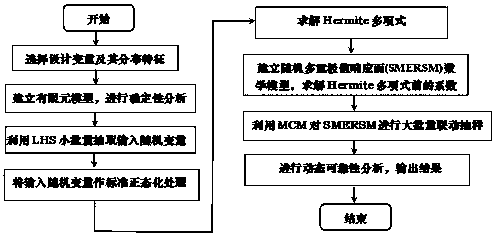A random multiple extreme value response surface method for reliability analysis of a flexible component
A flexible component, multiple extreme value technology, applied in the field of random multiple extreme value response surface method, can solve the problem of rarely fused multiple extreme value response surface method and so on
- Summary
- Abstract
- Description
- Claims
- Application Information
AI Technical Summary
Problems solved by technology
Method used
Image
Examples
Embodiment 1
[0020] A stochastic multiple extreme value response surface method for reliability analysis of flexible components, comprising the following steps:
[0021] a. Comprehensively consider the nonlinear material properties of the flexible member material and the combined effect of mechanical loads, and find the maximum output response point of the flexible member through static analysis;
[0022] b. Select the input random variable, use the Latin hypercube sampling technique (LHS) to sample the input random variable sample, and solve the finite element basic equation for each sample to obtain the corresponding output response;
[0023] c. Construct a stochastic multiple extreme value response surface function (SMERSF) to complete the reliability analysis of flexible member structures;
[0024] d. Verify the effectiveness of SMERSM.
Embodiment 2
[0026] According to the stochastic multiple extreme value response surface method of the flexible component reliability analysis described in embodiment 1, in the described step a, the density, elastic modulus, cross-sectional size, and each friction factor of the flexible component are used as input variables, considering the flexibility There is a coupling effect of clearance and mechanical load at the connection of components, and the basic finite element equations of components are solved, and deterministic analysis is carried out to find the maximum deformation point, maximum stress point and maximum strain point of flexible components.
Embodiment 3
[0028] According to the random multiple extreme value response surface method of flexible member reliability analysis described in embodiment 1, in the described step b, consider the randomness of data, use above-mentioned input variable as input random variable, use Latin hypercube sampling technique to extract Input random variable samples, solve the finite element basic equations for each sample, and obtain the corresponding dynamic output responses of deformation, stress, and strain in the analysis time domain.
PUM
 Login to View More
Login to View More Abstract
Description
Claims
Application Information
 Login to View More
Login to View More - R&D
- Intellectual Property
- Life Sciences
- Materials
- Tech Scout
- Unparalleled Data Quality
- Higher Quality Content
- 60% Fewer Hallucinations
Browse by: Latest US Patents, China's latest patents, Technical Efficacy Thesaurus, Application Domain, Technology Topic, Popular Technical Reports.
© 2025 PatSnap. All rights reserved.Legal|Privacy policy|Modern Slavery Act Transparency Statement|Sitemap|About US| Contact US: help@patsnap.com

